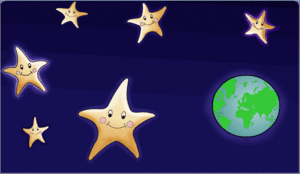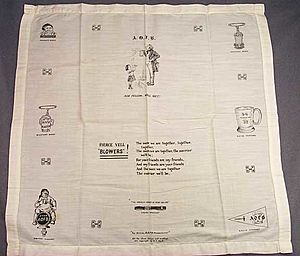Children's song facts for kids
A children's song is a tune made for kids. It can be a nursery rhyme put to music, a song children make up and share, or a new song created for fun, home use, or learning. Children's songs are found in every culture around the world. They are a big part of growing up!
Contents
What Are Children's Songs?
Experts who study children's culture, like Iona and Peter Opie, split children's songs into two main types. The first type includes songs that adults teach to children. These are often called nursery rhymes. The second type includes songs that children teach to each other. These songs are part of children's own secret world.
There are also songs written especially for kids in modern times. These are for entertainment or education. Sometimes, these different types mix. For example, children might change old nursery rhymes. Also, many traditional songs were actually written by adults for money long ago!
The Opies also sorted nursery rhymes into groups like:
- Action songs (like clapping games)
- Counting rhymes
- Lullabies (songs to help babies sleep)
- Riddles (songs that ask questions)
Songs children teach each other, often called playground or street rhymes, also have groups:
- Funny or silly verses
- Jingles (short, catchy tunes)
- Joke rhymes
- Nonsense verse (rhymes that don't make sense)
- Scary or spooky rhymes
- Parodies (funny copies of other songs)
- Popular songs (versions of hit songs)
- Slogans (short, memorable phrases)
- Tongue-twisters (hard-to-say phrases)
Since the 1800s, many songs have been written for children. These often sound like nursery rhymes, and some have even become popular traditional songs. They come from different places like:
Nursery Rhymes and Mother Goose Songs
The term nursery rhyme is used for old songs for young children in Britain and many English-speaking countries. But this name only started in the 1800s. In North America, people often still say Mother Goose rhyme.
The oldest children's songs we know about are lullabies. These songs are sung to help babies sleep and are found in every human culture. A very old lullaby from ancient Rome is "Lalla, Lalla, Lalla, aut dormi, aut lacte." Many old English songs about the birth of Jesus were also lullabies.
Most nursery rhymes we sing today come from the 1600s onwards. Some, like "To market, to market" and "Cock a doodle doo", are even older. But most were not written down until the 1700s. This was when children's books started to be made for fun, not just learning.
The first English collections of these songs were Tommy Thumb's Song Book (before 1744). At that time, they were called "Tommy Thumb's songs." The book Mother Goose's Melody (around 1785) was the first to record many classic rhymes we still know. These rhymes came from many places: old riddles, proverbs, ballads, parts of plays, drinking songs, and even historical events. About half of the "traditional" English rhymes we know were around by the mid-1700s.
In the early 1800s, printed rhyme books spread to other countries. This included Popular Rhymes of Scotland (1826) and Mother Goose's Melodies (1833) in the United States. We sometimes know who wrote these songs. For example, "Twinkle, Twinkle, Little Star" uses an old French tune with a poem by English writer Jane Taylor. "Mary Had a Little Lamb" was written by Sarah Josepha Hale in 1830.
Many early folk song collectors also gathered nursery rhymes. Famous collections include The Nursery Rhymes of England (1842) by James Orchard Halliwell. Later, books like A Book of Nursery Songs (1895) by Sabine Baring-Gould showed that studying children's songs had become a serious academic field. In the early 1900s, beautiful pictures were added to children's song books, like Arthur Rackham's Mother Goose (1913). The best study of English rhymes is still the work of Iona and Peter Opie.
Children's Playground and Street Songs
Unlike nursery rhymes, which adults pass down to children over many years, playground and street songs are learned and shared very quickly among kids. This fast sharing means new versions of songs can spread across a country in about a month! It also means songs change and adapt as words are forgotten or updated.
Where Do These Songs Come From?
Some playground rhymes from the mid-1900s can be traced back to the 1700s. Often, they came from popular adult songs, like ballads or tunes from music hall and minstrel shows. Children also love to take nursery rhymes, commercial kids' songs, and adult music and turn them into funny, silly versions.
A great example is the theme song from the 1950s Disney movie Davy Crockett, King of the Wild Frontier. The song, "The Ballad of Davy Crockett", started with the lines: "Born on a mountain top in Tennessee / The greenest state in the land of the free." Kids quickly made up endless funny versions, making Davy Crockett a spaceman or other silly things!
Action Songs
Some of the most popular playground songs include actions you do while singing. "I'm a Little Teapot" is a famous one. A term from this song is even used in cricket! A "teapot" is when a bowler stands with one hand on their hip, looking disappointed because a catch was dropped. A "double teapot" means both hands on hips with a disapproving stare!
Game Songs
Many children's playground and street songs are linked to specific games. These include clapping games like "Miss Susie" in America, "A sailor went to sea" in Britain, and "Mpeewa" in parts of Africa. Many traditional Māori children's games, like hand movement or stick games, also have special songs. In the Congo, the game "A Wa Nsabwee" involves two children syncing hand movements while singing. Skipping games, like Double Dutch, have even influenced hip hop and rap music!
If a playground song has a character, it's usually a child who is there or the child singing the song. The awkwardness between young boys and girls is a common theme. For example, the American song "K-I-S-S-I-N-G" is a jump-rope rhyme or taunt. It works best when sung to two kids who might like each other, making them blush! The song is passed down by kids telling each other:
[Name] and [Name]
sitting in a tree,
K-I-S-S-I-N-G.
First comes love,
then comes marriage,
then comes the baby
in a baby carriage!
Pastime Songs
Other songs have different patterns and uses. Many verses children use have a bit of rule-breaking or teasing. Kids often make fun of adult songs by changing the words. For example, "While shepherds watched their flocks by night" became "While shepherds washed their socks at night." This was very common in British playgrounds.
With more media and advertising, jingles from commercials and funny versions of them have become part of children's songs. The "McDonald's song" in the United States is an example. Humor is a big part of children's songs. Nonsense verses, like those by Edward Lear and Lewis Carroll, are popular in children's books. Many of these silly verses are also made up by children themselves.
Influence of Playground Songs
Sometimes, playground songs become the basis for modern pop songs. "Circle Circle Dot Dot", a common American playground song, has even been recorded as a rap song!
Commercial Children's Music
Commercial children's music grew from the popular music industry in the late 1800s and early 1900s. Early songs included "Ten little fingers and ten little toes" and "School Days" (1907). Perhaps the most famous is "Teddy Bears' Picnic", with lyrics from 1932 and a tune from 1907.
As recording technology improved, children's songs were sold on records. In 1888, the first records included Mother Goose nursery rhymes. Early record companies like Edison and Victor had special sections for children's music. Until the 1950s, all major record companies made albums for kids, often based on cartoons or nursery rhymes. Famous actors and singers would read or sing them.
Disney played a huge role in children's music from the 1930s. After their first full-length animated movie, Snow White and the Seven Dwarves (1937), they set the standard. They combined animation, fairy tales, and memorable songs. This continued into the 1970s with songs from films like Pinocchio (1940) and Song of the South (1946).
In the mid-1900s, the "baby boomers" (a large generation born after World War II) created a big market for children's music. Artists like Woody Guthrie and Pete Seeger made albums for kids. Fun songs like "Rudolph the Red-Nosed Reindeer" and the cartoon group Alvin and the Chipmunks were very popular.
In the 1960s, as the baby boomers grew up, they liked folk music. Folk artists like Peter, Paul, and Mary and Tom Paxton wrote albums for children. In the 1970s, TV shows like Sesame Street became very important for children's music.
In the early 1990s, Bobby Susser created his award-winning Bobby Susser Songs for Children series. These songs helped teach young children in schools and at home. Disney also made a comeback with animated musical movies like The Little Mermaid (1989). The song "Under the Sea" won an Oscar, starting a long line of Oscar-winning Disney songs.
The 2000s have seen more independent children's music artists. Acts like Dan Zanes, Cathy Bollinger, and Laurie Berkner became well-known on kids' TV channels. Bands like Trout Fishing in America combine folk music with family-friendly lyrics. Rock bands like They Might Be Giants have also released albums for children, such as No!, Here Come the ABCs, Here Come the 123s, and Here Comes Science.
See also
 In Spanish: Canción infantil para niños
In Spanish: Canción infantil para niños



